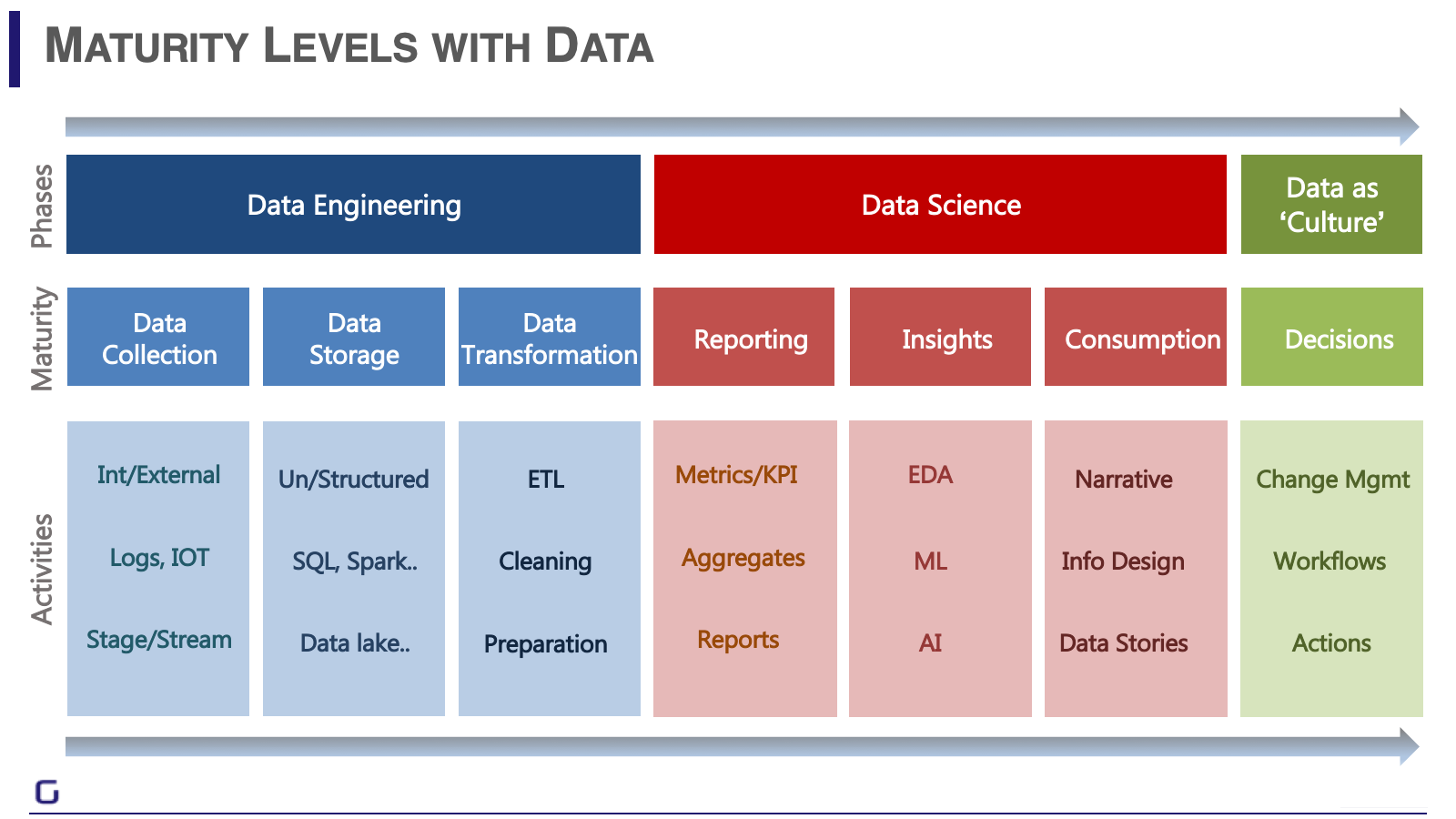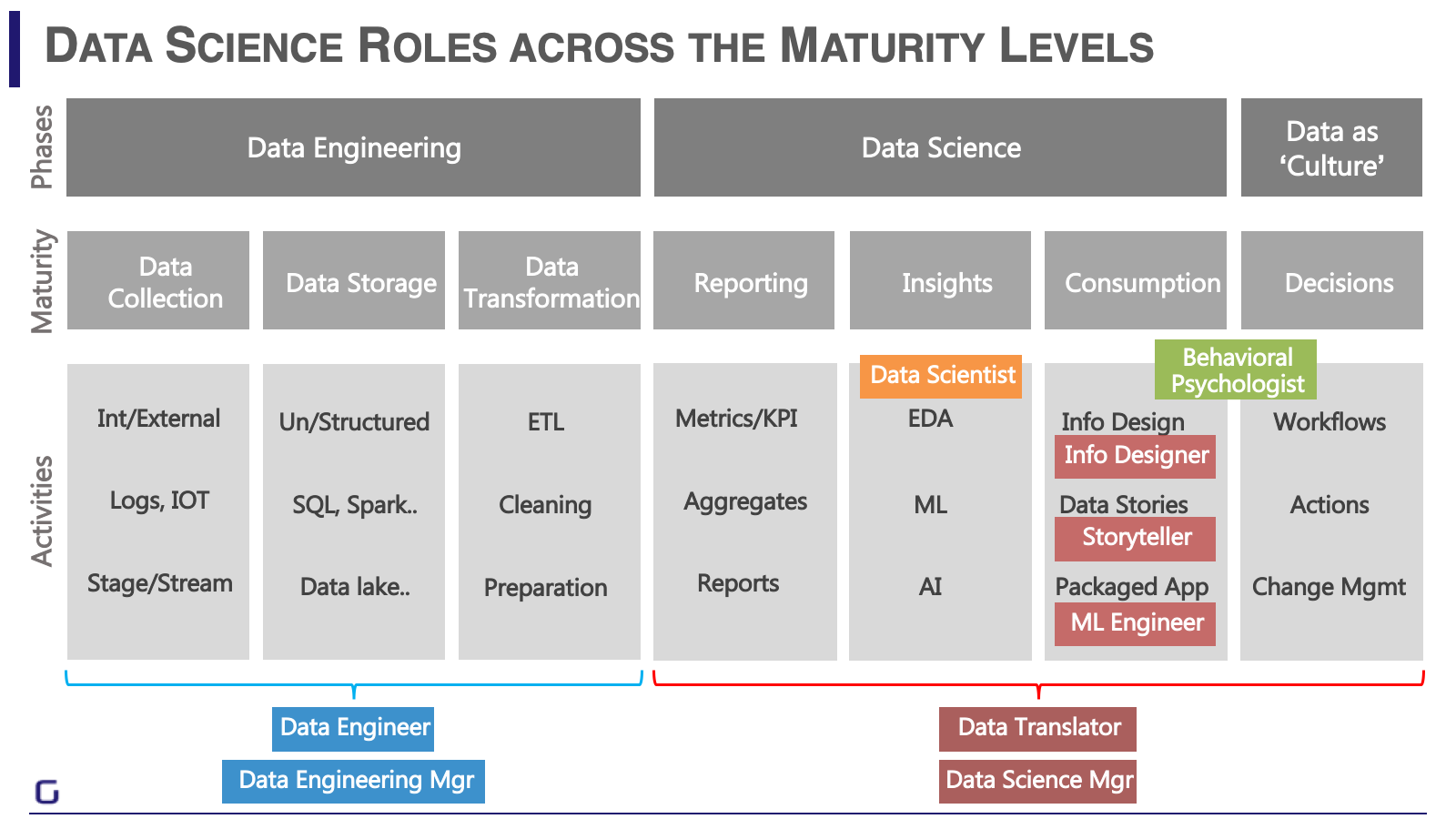Ganes Kesari
More posts from Ganes Kesari
Increasingly, startups across the spectrum are looking to artificial intelligence (AI) to help them solve business problems and drive efficiency. The numerous benefits of building AI capability in your startup shouldn’t come as a surprise to anyone — in fact, the advantages for business are so far-reaching that PwC predicts that AI will add $15.7 trillion to the global economy by 2030.
Contrary to popular belief, successfully implementing AI to drive impactful decisions requires a diverse team with expertise in several skill sets. Launching your AI journey is no simple feat — you need to ask probing questions to ensure that the relevant data science projects are embarked upon at the right time. Plus, you need to make sure that you build out an effective team that can turn data into decisions.
When should businesses take the AI leap?
Most startups are already using data to understand their business performance and make operational decisions, be it through MIS reports or KPIs tracked on Excel spreadsheets. But when should you level up to advanced analytics? At what point should you start leveraging AI technologies and build out your data science team?
Any startup looking to mature into data science needs to have access to credible data sources and clean data. So, a prerequisite is to leverage engineering practices to source data, then structure and store it. The first step in data science is looking at descriptive analytics to understand what happened in the past — this is usually achieved through KPI reports and simple summaries of business metrics.
After conducting descriptive analytics, you should then use exploratory data analysis to understand why things panned out the way they did. This is known as diagnostic analytics, and is powered by statistics and business analysis.
Once you find yourself seeking to extract more value from your data, you should plan for forward-looking analyses. Here, using AI and machine learning (ML) is vital to dive into deeper, predictive, data-driven insights.
Next along the data science journey is the consumption of these data insights and connecting them to business decisions. Data consumption is powered by narratives, information design, and data stories. The final data maturity level at an organization is when data becomes culture. This is where it is second nature for everyone in the organization to use data and leverage techniques like exploratory insights, ML and AI, either directly or indirectly to power decision-making.
When is the right time for data science?
But what about startups just starting out? Should you spend six months building out your data lakes before getting into insights? No. It’s never too early to start training AI and ML algorithms with whatever data you have at hand – just make sure you have the relevant, curated data from internal or external sources. Early on in your journey, it’s vital to put in place processes to clean and transform the data before you can start feeding it into your data science layer.
For example, let’s say a recently-launched ecommerce startup wants to leverage AI and ML to better understand its audience’s buying behavior. The data science team can collect the data from transaction logs, process it, and clean it. They can analyze this data to then generate insights on why people buy certain items and predict what they are likely to buy in the future. This provides the organization with key actionable insights into their consumer base early on rather than having to wait.
So, you’ve made the decision to take the leap into AI, and you’ve identified your AI vision and the likely use cases to get started with. How can you then build out your team to realize the benefits and scale the stages of maturity?
What makes a well-rounded data science team?
If you’re starting at the point of reporting and descriptive analytics – then you’re going to need a data translator. These folks are closest in skill to ‘business analysts’ in Business Intelligence (BI) teams. In addition to a strong business acumen, they have a flair for playing with data, a familiarity with analytics and an eye for design.
Data translators help identify the most impactful projects as they sculpt the business challenges into a shape that can be solved by data. With a strong understanding of the domain and data fluency and the ability to communicate effectively, they act as a bridge between business users, data engineers, and roles such as data scientists and information designers. This role is vital in data science teams working to drive business results – McKinsey estimates that demand for translators in the United States alone may reach two to four million by 2026.
Data scientists will find ways to uncover the most vital insights from your data with their knowledge of statistics, ML and AI techniques. You’ll also need information designers to make these insights consumable. Information designers are able to bring to life the visual intelligence layer of the insights, and use data visualization and visual design to weave engaging business stories from the insights.
Machine Learning engineers (ML engineers) are programmers who are fluent in data and are vital in productionizing the ML/AI models. They package the data science solution with the right insights in the back-end and the right storytelling in the front-end to enable business decisions. This team with its diverse skill set is best managed by data science managers. These are people who understand data, insights and stories, equally as well as their core expertise in people and project management.
Many organizations are institutionalizing the additional role of data storytellers. These people go beyond visualization dashboards by crafting a clear narrative from the data insights. They provide context to make insights digestible for everyone across the business. We humans are inherently “wired” with mechanisms that inhibit our ability to meaningfully engage with facts, according to this Gartner report. Stories are emotional, memorable and actionable. Without captivating data storytelling, you risk alienating your non-data science team members.
Organizations are also turning to arts and social disciplines to add a human dimension to data science. For example, a behavioral psychologist is better able to unveil the underlying reasons behind customer decisions like churn, purchases, and engagement. When combined with data insights, this human perspective allows organizations to have a deeper understanding of their customer base and make truly impactful decisions.
Structure business to foster a healthy data culture
For any startup just beginning its data science journey, building a versatile data science team and generating impactful insights is not going to happen overnight. Many organizations taking the first steps on this path struggle to come up with the right analytics initiatives and to identify deep business insights. They find it difficult to make the insights consumable and aren’t always able to ensure that the data science solutions get adopted by the target users.
That’s why analytics adoption needs an executive mandate and concerted efforts from the leadership to be a success. It’s crucial to plan change management initiatives to bring about a behavioral change in their teams to embrace data. You can achieve this by undertaking process interventions to build data-driven decision making into the team members’ business workflows.
A healthy data culture also needs to be supported by the right organizational structure that promotes collaboration between the data science team and business teams. An identified cross-functional core team with data science champions should lead the initiative and hand-hold end users. Organizational adoption and buy-in should be secured by reminding teams of the many business benefits – data-driven companies are growing at an average of more than 30% annually, compared to their counterparts.
Ultimately, every organization should envision a culture of data as their end goal. This happens when data powers deep insights and is consumed by the entire organization, making every decision potentially impactful. This changes not just the way teams operate internally on a day-to-day basis, but also in how business is conducted. Institutionalizing a culture of data can pave way to organizational transformation and competitive advantage in the market.






























Comment